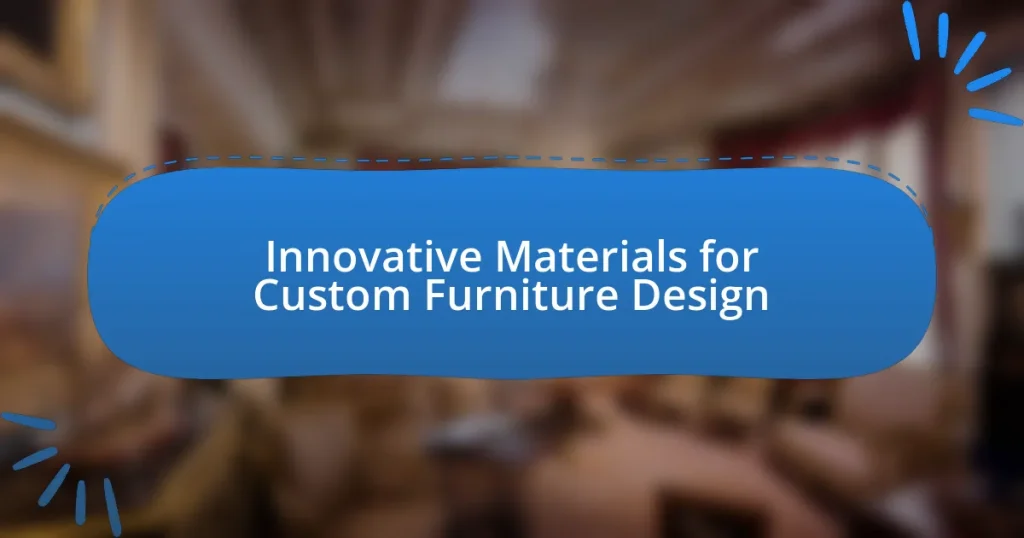Innovative materials for custom furniture design encompass a range of options including engineered wood, bioplastics, and metal composites, each offering unique benefits such as sustainability, durability, and design flexibility. These materials differ from traditional options by enhancing functionality and aesthetics, allowing for more creative and ergonomic designs. The article explores the characteristics, benefits, and growing popularity of these materials, as well as the role of technology and advancements in material science in shaping modern furniture design. Additionally, it addresses challenges designers face when incorporating innovative materials and highlights future trends and best practices for sustainable furniture solutions.

What are Innovative Materials for Custom Furniture Design?
Innovative materials for custom furniture design include engineered wood, bioplastics, and metal composites. Engineered wood, such as plywood and MDF, offers durability and versatility, allowing for intricate designs while being more sustainable than traditional solid wood. Bioplastics, derived from renewable sources, provide eco-friendly alternatives to conventional plastics, enabling unique shapes and finishes. Metal composites, combining materials like aluminum and fiberglass, enhance strength and aesthetic appeal, making them suitable for modern furniture applications. These materials not only meet functional requirements but also align with contemporary design trends focused on sustainability and innovation.
How do innovative materials differ from traditional materials in furniture design?
Innovative materials in furniture design differ from traditional materials primarily in their properties and applications, leading to enhanced functionality and aesthetics. For instance, materials like engineered wood, recycled plastics, and composites offer greater durability, sustainability, and design flexibility compared to solid wood or metal. These innovative materials can be molded into complex shapes, allowing for more creative and ergonomic designs, which traditional materials often cannot achieve. Additionally, innovative materials often incorporate technology, such as smart textiles or integrated lighting, which traditional materials lack, thus providing added value and modern features to furniture pieces.
What characteristics define innovative materials in this context?
Innovative materials in the context of custom furniture design are characterized by their sustainability, versatility, and advanced functionality. Sustainability is evident in materials that are eco-friendly, such as recycled plastics or sustainably sourced woods, which reduce environmental impact. Versatility is demonstrated through materials that can be easily manipulated or adapted for various designs, such as modular components or composite materials that combine different properties. Advanced functionality includes features like lightweight yet strong structures, self-healing surfaces, or smart materials that respond to environmental changes. These characteristics enhance the aesthetic appeal and usability of custom furniture, aligning with contemporary design trends and consumer preferences.
Why are innovative materials gaining popularity in custom furniture design?
Innovative materials are gaining popularity in custom furniture design due to their ability to enhance functionality, sustainability, and aesthetic appeal. These materials, such as recycled plastics, bamboo, and advanced composites, offer unique properties that traditional materials cannot match, including lightweight durability and eco-friendliness. For instance, the use of bamboo, which is a rapidly renewable resource, has increased by 20% in furniture production over the past decade, reflecting a growing consumer preference for sustainable options. Additionally, advancements in technology allow for the creation of materials that can be easily molded into complex shapes, enabling designers to push the boundaries of creativity while meeting consumer demands for personalized and functional furniture.
What types of innovative materials are commonly used in custom furniture design?
Innovative materials commonly used in custom furniture design include engineered wood, recycled plastics, and metal composites. Engineered wood, such as plywood and MDF, offers durability and versatility, making it a popular choice for custom pieces. Recycled plastics provide an eco-friendly option, allowing designers to create sustainable furniture while reducing waste. Metal composites, often used for their strength and aesthetic appeal, enable intricate designs and modern finishes. These materials are increasingly favored for their functionality, sustainability, and ability to meet diverse design needs.
What are the benefits of using sustainable materials in furniture design?
Using sustainable materials in furniture design offers significant environmental benefits, including reduced carbon footprint and conservation of natural resources. Sustainable materials, such as bamboo, reclaimed wood, and recycled metals, require less energy to produce and often involve less harmful manufacturing processes. For instance, bamboo grows rapidly and absorbs more carbon dioxide than traditional hardwoods, making it a more eco-friendly option. Additionally, utilizing reclaimed wood helps reduce deforestation and waste, as it repurposes existing materials rather than relying on new resources. These practices contribute to a more sustainable furniture industry, promoting ecological balance and supporting a circular economy.
How do composite materials enhance the functionality of custom furniture?
Composite materials enhance the functionality of custom furniture by providing superior strength, durability, and design flexibility. These materials, which combine two or more constituent materials, allow for lightweight yet robust structures that can withstand wear and tear better than traditional materials. For instance, the use of fiberglass-reinforced plastics in furniture can significantly increase resistance to impact and moisture, making it suitable for various environments. Additionally, composite materials can be molded into complex shapes, enabling innovative designs that maximize space and aesthetic appeal. This adaptability is supported by studies showing that composite materials can reduce weight by up to 30% while maintaining structural integrity, thus improving the overall usability of custom furniture.
What role does technology play in the development of innovative materials for furniture?
Technology plays a crucial role in the development of innovative materials for furniture by enabling the creation of advanced composites, sustainable resources, and smart materials. For instance, the use of computer-aided design (CAD) software allows designers to experiment with new material combinations and optimize structural integrity while minimizing waste. Additionally, advancements in manufacturing techniques, such as 3D printing, facilitate the production of complex geometries that were previously impossible, allowing for unique designs and customization. Research indicates that the global market for smart furniture, which incorporates technology like sensors and connectivity, is projected to grow significantly, reflecting the increasing integration of technology in furniture design.
How are 3D printing technologies influencing material choices in custom furniture?
3D printing technologies are significantly influencing material choices in custom furniture by enabling the use of diverse, innovative materials that were previously impractical or impossible to utilize. This technology allows designers to experiment with materials such as biodegradable plastics, composites, and even metals, which can be tailored to specific design requirements and functional needs. For instance, a study published in the journal “Additive Manufacturing” highlights that 3D printing facilitates the creation of complex geometries and lightweight structures, which can enhance both aesthetic appeal and structural integrity. Additionally, the ability to produce furniture on-demand reduces waste and allows for greater customization, aligning with sustainable design practices.
What advancements in material science are impacting furniture design?
Advancements in material science significantly impact furniture design by introducing innovative materials such as bioplastics, engineered wood, and smart textiles. Bioplastics, derived from renewable resources, offer sustainable alternatives to traditional plastics, reducing environmental impact while maintaining durability. Engineered wood products, like plywood and MDF, provide strength and versatility, allowing for complex shapes and designs that traditional solid wood cannot achieve. Smart textiles, embedded with technology, enhance functionality by enabling features like temperature regulation and stain resistance. These advancements not only improve the aesthetic and functional qualities of furniture but also align with sustainability goals, as evidenced by the growing trend of eco-friendly furniture options in the market.
How can designers effectively incorporate innovative materials into their projects?
Designers can effectively incorporate innovative materials into their projects by conducting thorough research on material properties and applications. Understanding the unique characteristics of materials such as sustainability, durability, and aesthetic appeal allows designers to select the most suitable options for their specific projects. For instance, using recycled plastics or bamboo can enhance sustainability while providing unique visual elements. Additionally, collaborating with material scientists or suppliers can provide insights into the latest advancements and potential uses of innovative materials, ensuring that designers stay ahead of trends and can leverage cutting-edge solutions in their designs.
What design principles should be considered when using new materials?
When using new materials in design, key principles to consider include sustainability, functionality, aesthetics, and durability. Sustainability ensures that materials are environmentally friendly and responsibly sourced, which is increasingly important in modern design practices. Functionality focuses on how well the material serves its intended purpose, impacting usability and performance. Aesthetics involves the visual appeal and how the material complements the overall design, influencing consumer attraction. Durability assesses the material’s ability to withstand wear and tear, ensuring longevity and reducing the need for replacements. These principles are essential for creating innovative and effective custom furniture designs that meet contemporary standards and consumer expectations.
How can innovative materials be combined for unique furniture solutions?
Innovative materials can be combined for unique furniture solutions by integrating elements such as sustainable wood, recycled metals, and advanced composites. This combination allows designers to create pieces that are not only aesthetically pleasing but also environmentally friendly and durable. For instance, using bamboo, a rapidly renewable resource, alongside aluminum, which is lightweight and recyclable, can result in furniture that is both strong and sustainable. Additionally, incorporating materials like resin-infused fabrics can enhance the visual appeal and functionality of the furniture, offering water resistance and easy maintenance. The trend towards using 3D printing technology further enables the creation of complex shapes and structures that traditional materials cannot achieve, thus expanding design possibilities.
What challenges do designers face when using innovative materials?
Designers face several challenges when using innovative materials, including material performance, cost implications, and sustainability concerns. Material performance can vary significantly, leading to difficulties in achieving desired durability and functionality. For instance, some innovative materials may not withstand wear and tear as effectively as traditional options, impacting the longevity of the furniture. Cost implications arise as many innovative materials can be more expensive to source and process, which can limit budget flexibility for projects. Additionally, sustainability concerns are prevalent, as designers must consider the environmental impact of new materials, including their sourcing, production processes, and end-of-life disposal. These challenges necessitate careful evaluation and testing to ensure that the innovative materials align with design goals and consumer expectations.
How can issues of cost and availability be addressed in material selection?
To address issues of cost and availability in material selection for custom furniture design, designers can utilize alternative materials that offer similar properties at a lower price point. For instance, using engineered wood instead of solid hardwood can significantly reduce costs while maintaining aesthetic appeal and structural integrity. Additionally, sourcing materials locally can mitigate transportation costs and improve availability, as highlighted by the trend towards sustainable design practices that prioritize local resources. Furthermore, leveraging technology such as 3D printing can enable the creation of custom components from less expensive materials, thus enhancing both affordability and accessibility.
What are the potential drawbacks of using certain innovative materials?
The potential drawbacks of using certain innovative materials in custom furniture design include high costs, limited availability, and environmental concerns. High costs can arise from the advanced technology and processes required to produce these materials, making them less accessible for budget-conscious consumers. Limited availability may hinder designers from sourcing specific innovative materials, impacting project timelines and design options. Environmental concerns often relate to the sustainability of the materials, as some may not be recyclable or could contribute to pollution during production. For instance, certain synthetic materials can release harmful chemicals, raising health and safety issues for both manufacturers and consumers.
What are the future trends in innovative materials for custom furniture design?
Future trends in innovative materials for custom furniture design include the increased use of sustainable materials, such as bamboo and recycled plastics, as well as advancements in smart materials that respond to environmental changes. Sustainable materials are gaining traction due to growing consumer demand for eco-friendly products, with bamboo being recognized for its rapid growth and minimal environmental impact. Additionally, smart materials, like shape-memory alloys and thermochromic polymers, are being integrated into furniture design to enhance functionality and user experience, allowing pieces to adapt to temperature or user preferences. These trends reflect a shift towards environmentally conscious and technologically advanced furniture solutions.
How might consumer preferences shape the development of new materials?
Consumer preferences significantly influence the development of new materials by driving demand for sustainability, aesthetics, and functionality. For instance, as consumers increasingly prioritize eco-friendly products, manufacturers are investing in biodegradable and recycled materials, such as bioplastics and reclaimed wood, to meet this demand. A report by the Ellen MacArthur Foundation highlights that 70% of consumers are willing to pay more for sustainable products, demonstrating a clear market trend that shapes material innovation. Additionally, preferences for unique designs and textures lead to the exploration of advanced composites and finishes that enhance the visual appeal and durability of furniture. This alignment between consumer desires and material development fosters a cycle of innovation that responds directly to market needs.
What innovations are on the horizon for sustainable furniture materials?
Innovations on the horizon for sustainable furniture materials include the development of mycelium-based composites, which utilize fungal networks to create biodegradable and durable materials. Research indicates that mycelium can be grown rapidly and requires minimal resources, making it an eco-friendly alternative to traditional materials. Additionally, advancements in recycled plastics are leading to the creation of high-quality furniture products that reduce waste and carbon footprint. For instance, companies are now producing furniture from ocean-bound plastics, which not only addresses pollution but also promotes circular economy practices. These innovations reflect a growing trend towards sustainability in the furniture industry, driven by both consumer demand and environmental necessity.
What best practices should be followed when selecting innovative materials for custom furniture?
When selecting innovative materials for custom furniture, prioritize sustainability, durability, and aesthetic appeal. Sustainable materials, such as bamboo or recycled metals, reduce environmental impact and appeal to eco-conscious consumers. Durability ensures longevity, with materials like high-density polyethylene or engineered wood providing resilience against wear and tear. Aesthetic appeal is crucial; materials should align with design trends and customer preferences, enhancing the overall visual impact of the furniture. Research indicates that 66% of consumers prefer brands that demonstrate environmental responsibility, highlighting the importance of sustainability in material selection.


